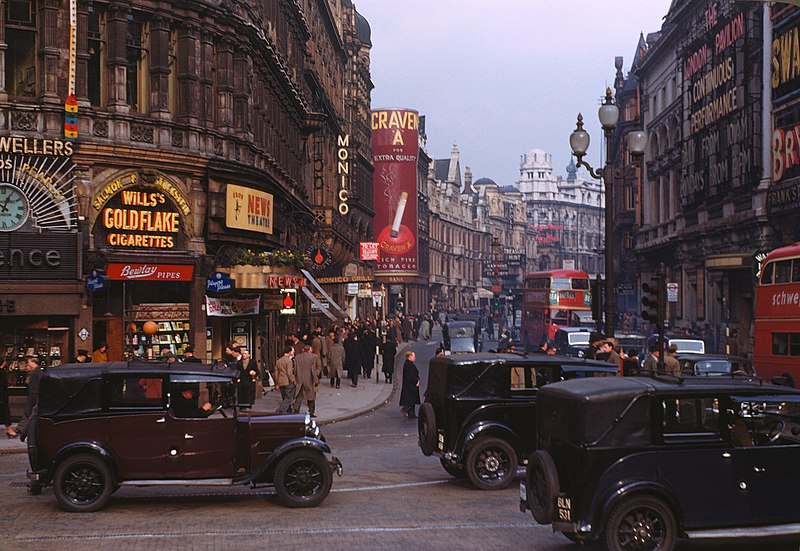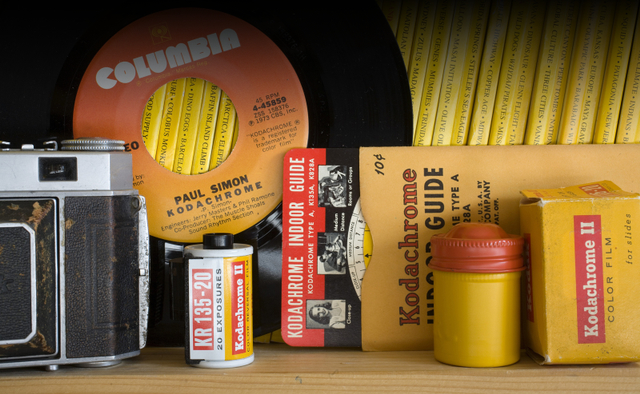Die beiden befreundeten Berufsmusiker Leopold Godowsky (mit der
Geige) und Leopold
Mannes experimentierten als begeisterte Hobbyfotografen mit allerlei
Fotochemie und stießen nach 1922 auf die Patente von Rudolf
Fischer, der die
chromogene Farbfotografie und damit das Prinzip des modernen
Farbfilms schon 1911 erfunden hatte. Leider konnte dieser das Problem der
unerwünschten Diffusion der Farbkuppler zwischen den verschiedenen
Gelatineschichten nicht lösen.
Godowsky und Mannes machten sich zunächst selbstständig an die Arbeit
wurden 1930 schließlich von
Kenneth Mees, dem Forschungsdirektor von Eastman Kodak nach Rochester,
NY gelockt, wo ihnen ein großes Labor und eine Schar von Mitarbeitern zur
Verfügung standen, um das fertig zu entwickeln, was wir als Kodachrome
kennengelernt haben.
"Man and God" (der Mensch und Gott), wie die beiden scherzhaft genannt
wurden, überwanden das Farbkuppler-Diffusionsproblem durch den sogenannten
"kontrollierten Diffusions-Bleichprozess", eine aufwändige 27-stufige
Entwicklungs-Prozedur. Das dazugehörige Patent US 2,113,329 wurde am
27. Februar 1935 angemeldet, also heute vor 76 Jahren. Auch in
Europa wurden entsprechende Patente angemeldet, in Deutschland u.a.
DRP 723388 und
DRP 631324. Der erste Film (ein 16 mm Schmalfilm) kam am 15. April 1935
auf den Markt und war damit der erste kommerzielle, moderne
Mehrschichten-Farbfilm.
Leopold Godowsky
(with the violin) and Leopold Mannes, two
friends and both professional musicians were also enthusiastic hobby
photographers. In 1922 they experimented with some photo chemistry and
discovered the patents of Rudolf
Fischer, who invented the the so-called
chromogenic color photography and with that the principle of the modern
color film already in 1911. Unfortunately, Fischer was not able to overcome
the problem of undesired diffusion of the color couplers between the
different gelatin layers.
At first Godowsky and Mannes started their own research lab. Eventually, in
1930 they were hired by
Kenneth Mees, research director of Eastman Kodak in Rochester, NY. At
Kodak's headquarters they headed a big new lab with a bunch of technicians
to help them. Finally, the group developed what we got to know as
Kodachrome.
"Man and God" how the two used to be named solved the problem by the
so-called controlled diffusion bleach process, a complicated 27 steps
comprising film development procedure. The appendant patent US 2,113,329 was filed
on February 27, 1935. Kodak also filed for patents in Europe, e.g. the
German applications
DRP 723388 and
DRP 631324. The first film (in form of a 16 mm movie film) was launched
on the market on April 15, 1935 and with this date Kodak won the race for
the first commercially available modern multilayer color film.
Etwas vereinfacht steht in den Patenten folgendes: Der Kodachrome ist im
Grunde ein reiner Schwarz-Weiß-Film mit u.a. drei für die jeweiligen Farben
Blau, Grün und Rot sensibilisiere
Emulsionsschichten. Zunächst gibt es eine S/W-Umkehrentwicklung
(Kodachrome ist ein Dia-Film) für alle drei Schichten gleichzeitig. Nach
Entfernung des ursprünglichen S/W-Negativ-Silbers wird nun stufenweise mit
der Farbentwicklung begonnen. Die einzelnen (und unterschiedlichen
Farbentwickler) enthalten neben der Entwicklersubstanz auch den
entsprechenden Farbkuppler. An den Stellen,
wo nun das positive Silberbild ist kommt es zur Reaktion zwischen beiden
und der unlösliche Farbstoff entsteht. Man beginnt mit dem Cyanfarbstoff
(rotempfindliche, unterste Schicht) und muss dann anschließend aus den
beiden anderen Schichten darüber diesen wieder ausbleichen. Dieser Schritt
ist die sogenannte diffusionskontrollierte Bleiche, der entscheidende
Schritt. Mit den beiden darüberliegenden Schichten verfährt man genauso,
d.h. zunächst den Magentafarbstoff in der mittleren Schicht erzeugen und in
der obersten wieder ausbleichen und am Schluss Yellow für die oberste Lage.
Am Ende wird alles Silber aus dem Film rausgelöst, alle überflüssigen
Chemikalien entfernt und es bleibt ein farbiges Diapositiv über.
What is described in the patents (somehow simplified): The Kodachrome
essentially is a pure black and white film comprising three photographic
emulsion layers, which are sensitized
for the respective colors red, green and blue.
First, there is a black and white reversal processing (Kodachrome was a reversal film) for all three layers. After removal of the B&W negative silver the color processing is done step-by-step, layer by layer. The respective color couplers are contained in the individual and different color developer solutions, but in their reduced form they do not react with each other. Only at the positions of the positive silver image a chemical reaction is triggered between the two, and the insoluble dye is formed. The process starts with the cyan dye (red-sensitive, bottom layer) and subsequently this has to be bleached from the other two layers on top again. This step is the so-called diffusion-bleaching, the crucial step. With the two top layers, the procedure is exactly the same: first generate the magenta dye in the middle layer and bleach it from the top layer and at the end again create yellow in the uppermost layer. At the end, all the silver is removed and all unnecessary chemicals are washed out. Voila: there is a color slide.
First, there is a black and white reversal processing (Kodachrome was a reversal film) for all three layers. After removal of the B&W negative silver the color processing is done step-by-step, layer by layer. The respective color couplers are contained in the individual and different color developer solutions, but in their reduced form they do not react with each other. Only at the positions of the positive silver image a chemical reaction is triggered between the two, and the insoluble dye is formed. The process starts with the cyan dye (red-sensitive, bottom layer) and subsequently this has to be bleached from the other two layers on top again. This step is the so-called diffusion-bleaching, the crucial step. With the two top layers, the procedure is exactly the same: first generate the magenta dye in the middle layer and bleach it from the top layer and at the end again create yellow in the uppermost layer. At the end, all the silver is removed and all unnecessary chemicals are washed out. Voila: there is a color slide.

|
| Kodachrome photo by Chalmers Butterfield of Shaftesbury Avenue from Piccadilly Circus, in the West End of London, c. 1949 (source: Wikimedia) |
Das Verfahren war so kompliziert, dass kein Fotograf oder gar Fotoamateur
seinen Kodachrome selbst entwickeln konnte. Kodak hat das übernommen, bzw.
in den USA nach einem Kartellstreit auch anderen Fachlaboren überlassen
(müssen). Auch wurde die Prozedur schon 1938 "vereinfacht": Die
diffusionskontrollierte Bleiche wurde durch die selektiven Nachbelichtungen
und eine sog. schleiernde Entwicklung ersetzt. Somit sind heute waren bis vor kurzem nur
noch 16 Schritte erforderlich, die ein geübtes Fachlabor in 30 Minuten
absolviert hat. Nach wie vor aber waren die Farbkuppler nicht im Film
selbst enthalten, sondern kamen aus der Entwickler-Lösung. Dies machte den
Kodachrome-Film nicht nur zum schärfsten, hochauflösendsten, sondern auch
gleichzeitig zum langlebigsten Farbfilm für über 50 Jahre!
The procedure was so complicated that neither professional nor amateur
photographers could process their Kodachrome by themselves. Initially Kodak
offered this service exclusively, but after an antitrust case in the US
they had to offer the processing chemicals also to independent labs. Also,
the procedure has been "simplified" in 1938: The diffusion-controlled
bleaching was replaced by selective re-exposure and a so-called
fogging development. Thus, today until recently, only 16 steps
were required to be completed by a trained specialized lab in about 30
minutes. As before, however, the color couplers were not contained in the
film itself, but were included in the developer solution. This made the
Kodachrome film not only the sharpest, the highest resolution, but at the
same time the most durable color film for over 50 years!
Der Kodachrome 64 (und später der Kodachrome 200) war auch mein
Lieblings-Diafilm, auch wenn ich ihn mir nicht immer leisten konnte und
daher auf preiswertere E6-Alternativen umgestiegen bin. Insbesondere für
Urlaubsreisen hatte er einen Vorteil: In der Packung war immer ein
Rücksendeumschlag zum Kodak-Labor (in Deutschland: Stuttgart), so dass man
die im Urlaub schon weggeschickten Filme bei der Rückkehr zuhause fertig
entwickelt im Briefkasten fand.
Aber es kam, wie es kommen musste. Mitte der 90er sind andere Filme
qualitativ endlich konkurrenzfähig und die Digitalfotografie versetzte
Kodachrome endgültig den Todesstoß.
Kodak hat am 22. Juni 2009 mitgeteilt auch den letzten verbliebenen
Filmtyp (den 64er) nicht mehr zu produzieren, am 30.12.2010
wurde der letzte Film entwickelt. Aber zum Trost: Er wird vermutlich
der einzige Film bleiben, der in einem populären Popsong besungen
wurde:
The Kodachrome 64 (and later Kodachrome 200) was my favorite slide film,
even if I could not afford it all the time and sometimes switched to
cheaper E6 alternatives. Especially for holiday trips, Kodachrome had an
advantage: In the pack was always a return envelope to the Kodak lab (in
Germany: Stuttgart). If you mailed the exposed films during the trip, you
would already find the slides in the mailbox when returning home.
But eventually the inevitable happened. During the 1990ies other films in
terms of quality became competitive and later the digital photo revolution
sounds the death knell for Kodachrome. On June 22nd, 2009 Kodak announced to discontinue
production of the last remaining film type (the 64), on December
30th, 2010 the last film was processed. But as some consolation,
Kodachrome will probably remain the only film a popular pop song was
dedicated to:
Für Interessierte zum weiterlesen: Nachrufe in
Foto-Intern, in der
Wiener Zeitung sowie von
Daily Mail, Geschichte auf Kodak's
eigener Homepage, technische Hintergründe zum Prozess in
Prof. Dr. Rudolf Gschwind, Imaging and Media Lab, Uni Basel,
Vorlesungsskript Bildtechnologie I, Teil 5, Kodak's
technisches Datenblatt zu den letzten Filmen, zum Schluss das Kodachrome Project
Further reading: Obituaries from
Foto-Intern, published by the
Wiener Zeitung as well as on
Daily Mail, History on Kodak's own
Homepage, technical background information about the process in
Prof. Dr. Rudolf Gschwind, Imaging and Media Lab, Uni Basel,
Vorlesungsskript Bildtechnologie I, Teil 5, Kodak's
technical data sheet about the last films, finally the Kodachrome Project
Die anderen Teile dieser kleinen Geschichts-Serie...
Other parts of this little history series...
1)
Invention of the modern multilayer color film - 100 Jahre moderner
Farbfilm2) Kodachrome
3) Agfacolor Neu
4) Ektachrome and Kodacolor





hallo!
AntwortenLöschenich hab diesen schönen Artikel mit meiner Webseite verlinkt >>> http://www.dagiebrundert.de/Entwickelservice.html - rechte Spalte - hoffe, das ist OK!
Dieser Kommentar wurde vom Autor entfernt.
AntwortenLöschenDanke ;-)
AntwortenLöschen